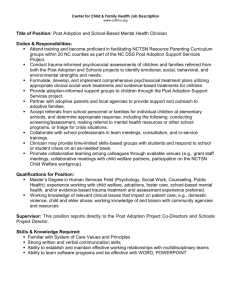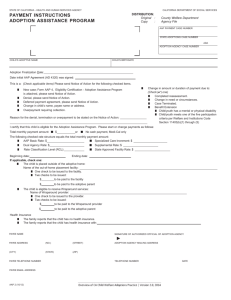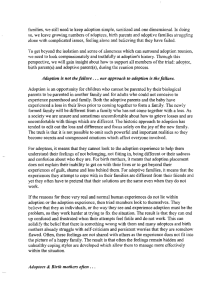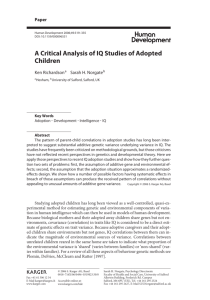Tackling Tricky Assignments
advertisement
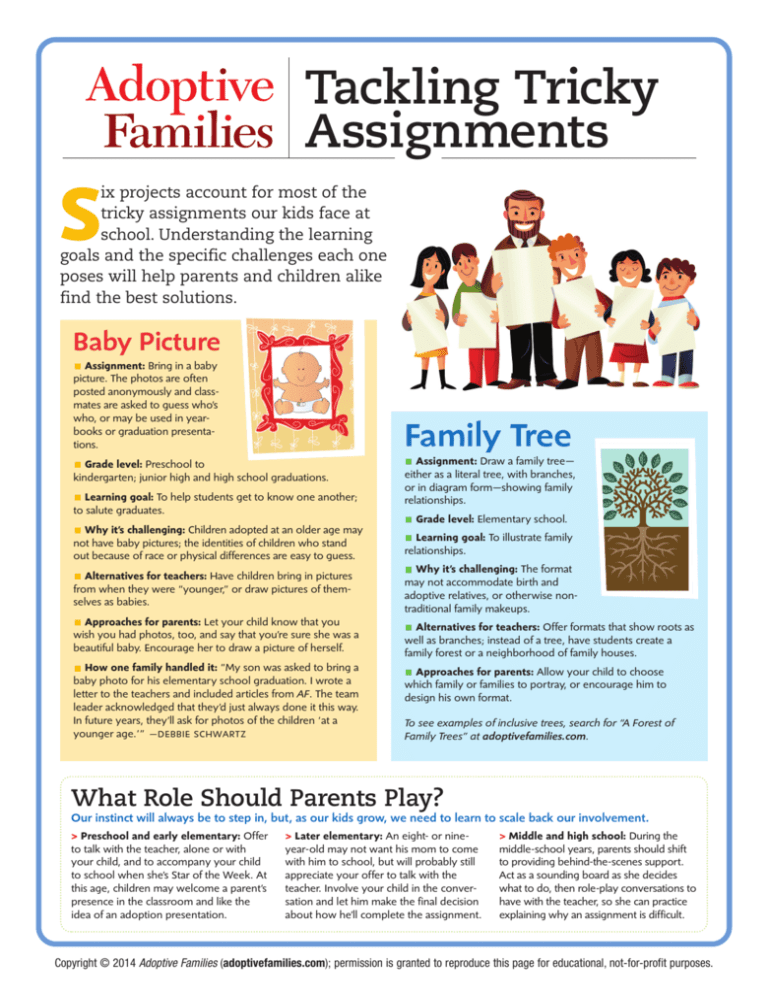
Tackling Tricky Assignments S ix projects account for most of the tricky assignments our kids face at school. Understanding the learning goals and the specific challenges each one poses will help parents and children alike find the best solutions. Baby Picture Assignment: Bring in a baby picture. The photos are often posted anonymously and classmates are asked to guess who’s who, or may be used in yearbooks or graduation presentations. Family Tree Grade level: Preschool to kindergarten; junior high and high school graduations. Learning goal: To help students get to know one another; to salute graduates. Why it’s challenging: Children adopted at an older age may not have baby pictures; the identities of children who stand out because of race or physical differences are easy to guess. Alternatives for teachers: Have children bring in pictures from when they were “younger,” or draw pictures of themselves as babies. Approaches for parents: Let your child know that you wish you had photos, too, and say that you’re sure she was a beautiful baby. Encourage her to draw a picture of herself. How one family handled it: “My son was asked to bring a baby photo for his elementary school graduation. I wrote a letter to the teachers and included articles from AF. The team leader acknowledged that they’d just always done it this way. In future years, they’ll ask for photos of the children ‘at a younger age.’” —DEBBIE SCHWARTZ Assignment: Draw a family tree— either as a literal tree, with branches, or in diagram form—showing family relationships. Grade level: Elementary school. Learning goal: To illustrate family relationships. Why it’s challenging: The format may not accommodate birth and adoptive relatives, or otherwise nontraditional family makeups. Alternatives for teachers: Offer formats that show roots as well as branches; instead of a tree, have students create a family forest or a neighborhood of family houses. Approaches for parents: Allow your child to choose which family or families to portray, or encourage him to design his own format. To see examples of inclusive trees, search for “A Forest of Family Trees” at adoptivefamilies.com. What Role Should Parents Play? Our instinct will always be to step in, but, as our kids grow, we need to learn to scale back our involvement. > Preschool and early elementary: Offer to talk with the teacher, alone or with your child, and to accompany your child to school when she’s Star of the Week. At this age, children may welcome a parent’s presence in the classroom and like the idea of an adoption presentation. > Later elementary: An eight- or nineyear-old may not want his mom to come with him to school, but will probably still appreciate your offer to talk with the teacher. Involve your child in the conversation and let him make the final decision about how he’ll complete the assignment. > Middle and high school: During the middle-school years, parents should shift to providing behind-the-scenes support. Act as a sounding board as she decides what to do, then role-play conversations to have with the teacher, so she can practice explaining why an assignment is difficult. Copyright © 2014 Adoptive Families (adoptivefamilies.com); permission is granted to reproduce this page for educational, not-for-profit purposes. Star of the Week Helpful Resources Assignment: During the child’s turn as Star of the Week, create and present a poster with the child’s story and family photos. Grade level: Kindergarten to first grade. Learning goal: To help students get to know one another; also serves as a leadership opportunity. Why it’s challenging: When our kids are placed in the spotlight, adoption often comes up, and they may not feel comfortable handling intrusive questions. Alternatives for teachers: Instead of focusing on the child’s past, let the Star of the Week talk about pets, current hobbies, and other elements of her life. Approaches for parents: Role-play possible responses to questions in advance. Ask your child about accompanying her to school to give an adoption presentation. How one family handled it: “After my five-year-old presented her poster, a classmate asked, ‘Where’s your father?’ My daughter cheerfully explained that she did not have a father, that she was adopted. Then: ‘Is that why you look different from your mom?’ The teacher reported that what followed was a discussion about adoption— and that my daughter handled it with competence and grace.” —CARRIE KRUEGER Heritage Exploration Assignment: Write a report, make a flag, or participate in a cultural celebration based on the student’s country or culture of origin. Grade level: Elementary through high school. Learning goal: To learn about different cultures. Why it’s challenging: A child’s ethnic or cultural heritage may differ from that of his family. A teacher may direct a student to write about her birth heritage, even though she would rather write about her adoptive family’s, or vice versa. Alternatives for teachers: Let students report on a country or culture of interest rather than one related to their family. Approaches for parents: Provide any available resources relating to his adoptive and birth family cultures. Accompany your child to class, if appropriate, to help conduct a presentation. Charting Genetic Traits Assignment: Diagram or write about the presence of a particular trait in the child’s family, such as eye or hair color. Grade level: Junior high through high school; occasionally late elementary school. Learning goal: To help children understand how genetic traits are passed along through generations. Why it’s challenging: Charting traits in an adoptive family may raise unwanted questions, and a child may not have much information about birth relatives. Alternatives for teachers: Study genetics in insects or plants. Use historical examples, such as the prevalence of inherited diseases in the royal families of Europe. Approaches for parents: Help your child identify friends or a biologically related family group, such as grandparents or cousins, on which to base a genetic chart. www.adoptivefamilies.com adoptivefamilies.com’s School channel. Advice from AF’s archives on talking to the teacher and preparing your child to answer questions, along with sample adoption presentations and family trees. Adoption and the Schools, ed. by Lansing Wood and Nancy Ng (fair families.org) and S.A.F.E. at School, by Marilyn Schoettle (adoption support.org). These guides help parents and teachers work together to ensure a positive school environment. Timeline Assignment: Create an historical timeline using a child’s own life events from birth to present. Grade level: Elementary through junior high school. Learning goal: To learn how to chart historical events on a timeline. Why it’s challenging: A child may be unsure of the time, the location, or even the date of his birth; he may wonder if he needs to include the dates he was relinquished by his birth family and placed with his adoptive family, or other private information. Alternatives for teachers: Do not specify that the timeline must begin at birth. Define it generally as “past, present, and future.” Allow children to create a timeline surrounding an historical event or fictional character. Approaches for parents: Help your child decide how to define “significant events,” and to choose what she wants to keep private. Encourage her to use general labels, such as “When I Was One,” rather than specific dates. How one family handled it: “Our daughter, adopted at age 12, was assigned a timeline of ‘milestone events’ on her first day of middle school, and she worried that this list would be too revealing. I explained that the goal was to learn to use timelines, and that she was under no obligation to reveal private details. So she listed events—learning to ride a bike, moving to a new town, winning an award—that she was happy to share with classmates.” —KATHRYN REISS
